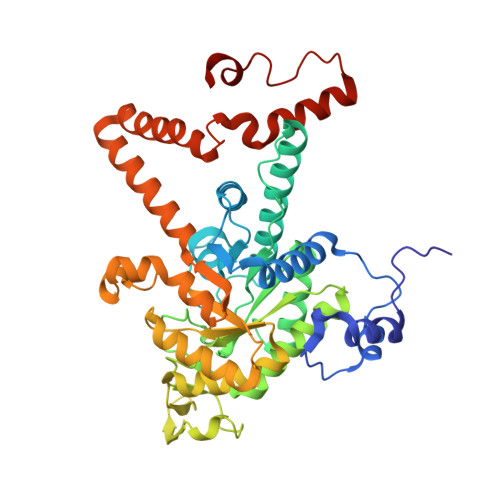Mechanism-Based Inactivation of Mycobacterium tuberculosis Isocitrate Lyase 1 by (2 R ,3 S )-2-Hydroxy-3-(nitromethyl)succinic acid.
Mellott, D.M., Torres, D., Krieger, I.V., Cameron, S.A., Moghadamchargari, Z., Laganowsky, A., Sacchettini, J.C., Meek, T.D., Harris, L.D.(2021) J Am Chem Soc 143: 17666-17676
- PubMed: 34664502
- DOI: https://doi.org/10.1021/jacs.1c07970
- Primary Citation of Related Structures:
7RB1 - PubMed Abstract:
The isocitrate lyase paralogs of Mycobacterium tuberculosis (ICL1 and 2) are essential for mycobacterial persistence and constitute targets for the development of antituberculosis agents. We report that (2 R ,3 S )-2-hydroxy-3-(nitromethyl)succinic acid (5-NIC) undergoes apparent retro-aldol cleavage as catalyzed by ICL1 to produce glyoxylate and 3-nitropropionic acid (3-NP), the latter of which is a covalent-inactivating agent of ICL1. Kinetic analysis of this reaction identified that 5-NIC serves as a robust and efficient mechanism-based inactivator of ICL1 ( k inact / K I = (1.3 ¡À 0.1) ¡Á 10 3 M -1 s -1 ) with a partition ratio <1. Using enzyme kinetics, mass spectrometry, and X-ray crystallography, we identified that the reaction of the 5-NIC-derived 3-NP with the Cys 191 thiolate of ICL1 results in formation of an ICL1-thiohydroxamate adduct as predicted. One aspect of the design of 5-NIC was to lower its overall charge compared to isocitrate to assist with cell permeability. Accordingly, the absence of the third carboxylate group will simplify the synthesis of pro-drug forms of 5-NIC for characterization in cell-infection models of M. tuberculosis.
Organizational Affiliation:
Department of Biochemistry and Biophysics, Texas A&M University, College Station, Texas 77843, United States.



















